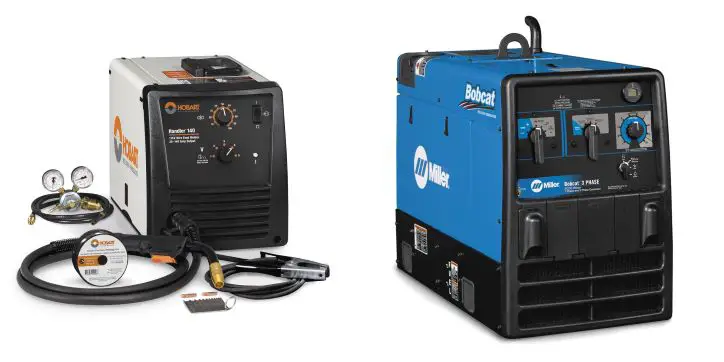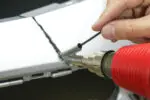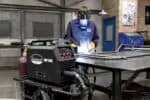The power supply system is divided into two types: single phase and three phase systems. Welding is the most effective method of joining metals. You may have noticed that some welders use three-phase power and others use single-phase power.
Single phase is used in places where less power is required to power small loads. When a large amount of power is required, three phases are used in large industries, factories, and manufacturing units. Another significant difference between three-phase and single-phase power is the consistency of power delivery.
What is a single phase?
The conductor and neutral wires are required for the single phase circuit to be completed. The current is carried by the conductor, and the current returns via the neutral.
The single phase provides a voltage of up to 230 volts. It is primarily used to power small appliances such as a fan, cooler, grinder, heater, and so on.
Advantages
1.) Single-phase connections are intended for household supplies and private residences. Because most appliances, such as televisions, lights, fans, and refrigerators, require only a small amount of electricity to operate.
2.) A single-phase connection operates in an uncomplicated manner. It is made up of a small and lightweight unit that reduces the flow of electricity through the wires as the voltage increases.
3.) Because of the power reduction, the power from a single-phase connection operates at peak efficiency and transmits power effectively.
4.) A single-phase connection is best suited for units rated up to 5 horsepower.
Disadvantages
1.) Industrial motors and other heavy machinery cannot run on a single-phase power supply.
2.) Small motors less than one Kilowatt cannot run on a single-phase power supply due to the lack of initial torque required by the motor. As a result, for the motor to run smoothly, additional equipment known as a motor starter is required.
What is a three phase?
A three-phase system is made up of four wires, three conductors, and one neutral. The conductors are out of phase and spaced 120 degrees apart.
The three-phase system can also function as a single-phase system. One phase and neutral can be drawn from the three phase supply for the low load.
The three-phase power supply is continuous and never goes completely dark. Power in a three-phase system can be drawn in either a star or a delta configuration. Because it has a neutral for the fault current, the star connection is used for long-distance transmission.
Advantages
1.) Because it has enough power to provide the necessary torque, it does not require any additional starters to run heavy industrial motors.
2.) Large machinery operates efficiently. Because of the high electricity demand, industrial and commercial loads prefer a three-phase connection.
3.) The voltage of three-phase power becomes smoother as the number of phases in the supply system increases.
4.) To transmit electrical power, the three-phase connection does not require an abundance of conducting materials. As a result, when it comes to providing a cost-effective solution, a three-phase connection is more cost-effective.
Disadvantages
1.) A three-phase connection’s main disadvantage is its inability to handle overload. As a result, it may cause equipment damage, increasing the likelihood of costly repairs. This is because individual components are expensive.
2.) Small motors less than one Kilowatt cannot run on a single-phase power supply due to the lack of initial torque required by the motor.
3.) As a result, for the motor to run smoothly, additional equipment known as a motor starter is required.
Here are the key distinctions between single-phase and three-phase connections.
1.) In a single-phase connection, electricity flows through a single conductor. A three-phase connection, on the other hand, consists of three separate conductors needed for electricity transmission.
2.) A single-phase power supply system’s voltage can reach 230 volts. On a three-phase connection, however, it can carry up to 415 volts.
3.) A single-phase connection requires two separate wires for a smooth flow of electricity. One is a neutral wire, and the other is a single phase. This is necessary to complete the circuit. The system requires one neutral wire and three phase wires to complete a three-phase connection.
4.) A three-phase connection transmits the most power when compared to a single phase power supply.
5.) A single-phase connection consists of two wires that form the foundation of a basic network. A three-phase connection, on the other hand, complicates the network because there are four different wires.
6.) Because there is only one phase wire in a single-phase connection, if something goes wrong with the network, the entire power supply is disrupted. However, in a three-phase power supply, if one phase fails, the other phases continue to operate. As a result, no power outage occurs.
7.) A single-phase connection is less efficient than a three-phase connection in terms of efficiency.
Let us look at the differences with the help of the table below:
Benefits of a three-phase system over a single-phase system
A three-phase power supply system has the following advantages over a single-phase power supply system.
1.) A three phase system requires less conductor material than a single phase system to transmit a specific power over a specific distance at a given rated voltage.
2.) A three phase system operated machine is smaller in size than a single phase voltage operated machine with the same output rating.
3.) The less voltage drop occurs from the source to the load points in a three phase power supply system, the better.
4.) A three phase system provides constant power, whereas a single phase system provides pulsating power, resulting in a smooth and vibration free operation of a three machine as opposed to noise and vibration in a one machine.
5.) A three phase machine with the same rating takes up less space than a single phase machine.
6.) To power the 1-phase machines, a single phase supply can be obtained from a three phase supply. A three-phase machine cannot be run on a single-phase power supply.
7.) Because a three-phase supply produces a uniform rotating magnetic field, three-phase motors are simpler to build, smaller in size, and can be started automatically and smoothly.
8.) When compared to a single phase system, a three phase system can transmit more power.
9.) The efficiency of three-phase devices and appliances is greater than that of single-phase machines.
10.) Three-phase machines are both less expensive and more efficient.
11.) A three-phase supply can be easily converted to a single-phase supply, whereas converting a single-phase supply to a three-phase supply requires a complex system.
12.) If a single phase line fails, the entire system must be shut down. In the event of a three-phase single-line fault, the other two lines supply power to other single-phase load points connected to them.
13.) Single phase motors cannot be started automatically, whereas three phase motors can.
14.) Three phase motors have a higher power factor than single phase motors.
FAQs-
Is it possible to have three-phase power in the home?
As previously stated, 3-phase power is appropriate for large industries and commercial areas that require a constant power supply.
Single-phase power is adequate for home use. If you are determined to use three-phase power in your home, it is possible. It isn’t practical, but you can still take it.
If your home has a high demand for electricity, your electricity distribution company should be able to supply it without issue. If the law requires it, you may be required to obtain a permit from the local authorities.
Is it possible to have three-phase power in the home?
As previously stated, 3-phase power is appropriate for large industries and commercial areas that require a constant power supply.
Single-phase power is adequate for home use. If you are determined to use three-phase power in your home, it is possible. It isn’t practical, but you can still take it.
Conclusion
Both single phase and three phase welders have their pros and cons. However, three phase welders are versatile, therefore, more reliable for heavy workload.
Each welder has their own market. Because single-phase power is more common in homes, you’ll need some workarounds to use a 3-phase welder at home.










